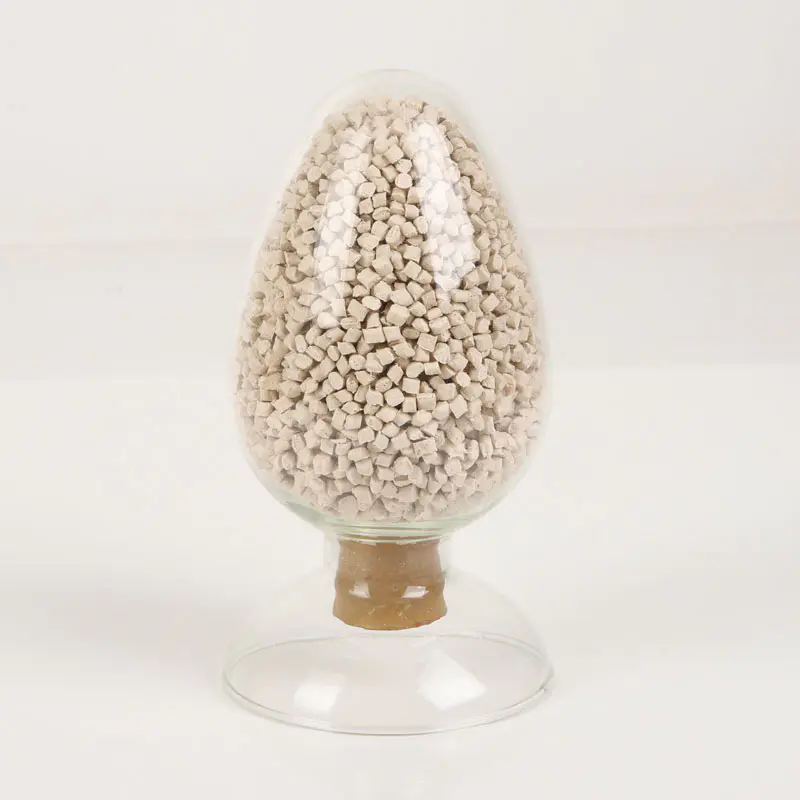Why Is Bamboo Fiber Plastic Becoming the Next Generation of Eco-Friendly Materials?
2025-10-14
Bamboo Fiber Plastic, also known as bamboo fiber-reinforced composite material, represents a revolutionary step in sustainable manufacturing. It combines natural bamboo fibers with biodegradable or recyclable polymers to create a durable, eco-friendly alternative to conventional plastics. With increasing global concern about plastic pollution and carbon emissions, this composite material offers a realistic solution for industries seeking to balance performance, sustainability, and cost-effectiveness.
The material is derived from renewable bamboo—one of the fastest-growing plants on Earth—mixed with polymers such as polypropylene (PP), polyethylene (PE), or polylactic acid (PLA). Through advanced processing techniques like extrusion and injection molding, the two components are fused to form a composite that is lightweight, strong, and environmentally responsible.
Core Characteristics of Bamboo Fiber Plastic:
-
Sustainability: Made from renewable bamboo resources.
-
Durability: Offers excellent resistance to moisture and wear.
-
Biodegradability: Certain blends can decompose naturally.
-
Thermal Stability: Performs well under various temperature conditions.
-
Aesthetic Appeal: Natural bamboo texture and color enhance product appearance.
Product Parameters Overview
| Parameter | Specification Range | Description |
|---|---|---|
| Bamboo Fiber Content | 30% – 70% | Varies by product requirement |
| Density | 1.1 – 1.4 g/cm³ | Lightweight with high rigidity |
| Tensile Strength | 35 – 60 MPa | Excellent structural strength |
| Impact Resistance | 4 – 7 kJ/m² | Resilient under physical stress |
| Water Absorption Rate | ≤ 0.5% | Enhanced moisture resistance |
| Thermal Deformation Temperature | 90 – 120°C | Stable in diverse environments |
| Available Colors | Natural, Customizable | Aesthetic flexibility |
| Processing Methods | Injection, Extrusion, Compression Molding | Supports mass production |
This combination of properties allows Bamboo Fiber Plastic to perform comparably—or even superiorly—to conventional plastics like ABS or PVC, while maintaining environmental integrity.
Why Is Bamboo Fiber Plastic an Ideal Replacement for Traditional Plastics?
In an era where environmental accountability drives purchasing decisions, Bamboo Fiber Plastic stands out as a sustainable innovation. It directly addresses the urgent need to reduce dependence on fossil fuel-based plastics that contribute to ocean pollution and landfill waste.
Key Advantages of Bamboo Fiber Plastic:
-
Eco-Friendly and Renewable
Bamboo grows rapidly without chemical fertilizers or pesticides, and its cultivation enriches rather than depletes the soil. This makes bamboo-based composites a renewable and low-impact material. -
Lower Carbon Footprint
The production of Bamboo Fiber Plastic requires less energy than conventional plastics, significantly reducing CO₂ emissions throughout the supply chain. -
Superior Mechanical Properties
The natural fiber reinforcement enhances strength, stiffness, and impact resistance—qualities highly valued in packaging, automotive, and construction industries. -
Aesthetic and Natural Appeal
Products made with Bamboo Fiber Plastic feature a subtle, natural texture that appeals to consumers seeking eco-conscious yet stylish alternatives. -
Thermal and UV Resistance
Its ability to maintain stability under temperature fluctuations and UV exposure makes it suitable for both indoor and outdoor applications. -
Cost Efficiency Over Time
Though the initial investment may be slightly higher, its durability and recyclability make Bamboo Fiber Plastic cost-effective in the long run.
Common Applications Include:
-
Household Products: Cutlery, cups, plates, toothbrush handles, and storage boxes.
-
Automotive Components: Interior panels, dashboards, and trims.
-
Construction Materials: Decorative boards, tiles, and flooring materials.
-
Consumer Electronics: Casings, buttons, and outer shells for devices.
-
Packaging Solutions: Eco-friendly containers, trays, and disposable packaging.
These applications demonstrate how industries are transitioning toward Bamboo Fiber Plastic not only for its ecological benefits but also for its versatility and performance.
How Is Bamboo Fiber Plastic Manufactured and What Are Its Technological Advantages?
The manufacturing of Bamboo Fiber Plastic involves precise blending and processing to achieve optimal performance. The process typically consists of several stages, from fiber treatment to final molding.
Step-by-Step Manufacturing Process:
-
Fiber Preparation:
Bamboo stalks are crushed and processed to extract fibers. The fibers are cleaned, dried, and cut to specific lengths for consistency. -
Surface Treatment:
Fibers are treated with coupling agents to improve compatibility with polymers, ensuring better adhesion and dispersion in the plastic matrix. -
Compounding:
Treated bamboo fibers are mixed with thermoplastic polymers like PP, PE, or biodegradable PLA through an extrusion compounding process. Additives such as lubricants, stabilizers, and colorants may be included to enhance material performance. -
Pelletization:
The compounded material is cooled and cut into pellets, which can be easily used in various molding applications. -
Forming and Molding:
These pellets are then processed through injection molding, extrusion, or compression molding, depending on the end-use product design.
Technological Advantages:
-
Enhanced Fiber Dispersion: Advanced compounding ensures uniform fiber distribution, reducing defects.
-
Improved Thermal Stability: Maintains shape and mechanical integrity even under heat.
-
Customization Options: Can be engineered for specific applications with varying fiber content.
-
Eco-Compatible Production: Utilizes non-toxic additives and produces minimal industrial waste.
Future Technological Trends:
The next generation of Bamboo Fiber Plastic is expected to incorporate bio-based resins and nanocellulose reinforcements, leading to even greater strength, biodegradability, and performance consistency. Researchers are also exploring smart composites capable of self-repair or responsive behavior under environmental changes.
As environmental regulations tighten globally, these innovations will make Bamboo Fiber Plastic one of the primary materials driving sustainable industry transformation.
What Is the Market Outlook and Why Will Bamboo Fiber Plastic Lead Future Eco-Manufacturing?
The market for Bamboo Fiber Plastic is expanding rapidly across North America, Europe, and Asia-Pacific. Driven by governmental sustainability mandates, green manufacturing incentives, and consumer demand for eco-friendly products, the global bamboo plastic composites market is projected to grow significantly over the next decade.
Market Growth Factors:
-
Sustainability Mandates: Regulatory bans on single-use plastics boost adoption.
-
Consumer Awareness: Increased environmental consciousness influences purchasing behavior.
-
Corporate Responsibility: Businesses seek sustainable branding opportunities.
-
Technological Advancements: Continuous R&D improves performance and reduces costs.
Industries Embracing Bamboo Fiber Plastic:
-
Automotive: Lightweight and high-strength parts enhance fuel efficiency.
-
Construction: Durable and mold-resistant panels replace traditional plastic or wood.
-
Consumer Goods: Eco-friendly packaging and homeware attract green-conscious buyers.
-
Electronics: Provides a renewable option for sustainable device casings.
The demand surge signifies a shift in how industries view material sustainability—not as an option but as a necessity for long-term competitiveness.
FAQs About Bamboo Fiber Plastic
Q1: Is Bamboo Fiber Plastic completely biodegradable?
A1: Not all types are fully biodegradable. The biodegradability depends on the type of polymer used. When combined with PLA or other bio-based resins, Bamboo Fiber Plastic can decompose naturally under specific composting conditions. However, when paired with traditional thermoplastics like PP or PE, it becomes recyclable rather than biodegradable.
Q2: How does Bamboo Fiber Plastic perform compared to regular plastic?
A2: Bamboo Fiber Plastic outperforms regular plastic in tensile strength, rigidity, and thermal stability. It also offers a natural texture and environmental benefits that traditional plastics cannot match. Moreover, it emits fewer greenhouse gases during production, aligning with global sustainability goals.
The Future Belongs to Sustainable Materials Like Bamboo Fiber Plastic
As industries worldwide pivot toward eco-conscious innovation, Bamboo Fiber Plastic stands at the forefront of sustainable material science. Its combination of renewable resources, advanced engineering, and versatile applications makes it a powerful replacement for fossil-fuel-based plastics.
Leading manufacturers continue to refine its composition for enhanced performance and environmental compliance, ensuring that this material will play a vital role in the green economy.
Jiangsu Jinhe, a pioneer in bamboo composite development, offers premium-grade Bamboo Fiber Plastic solutions designed to meet global quality standards. The company’s ongoing innovation and commitment to environmental responsibility make it a trusted partner for businesses seeking sustainable material alternatives.
For more information on product specifications, customization options, or partnership opportunities, contact us to discover how Bamboo Fiber Plastic can redefine your manufacturing process for a greener future.



